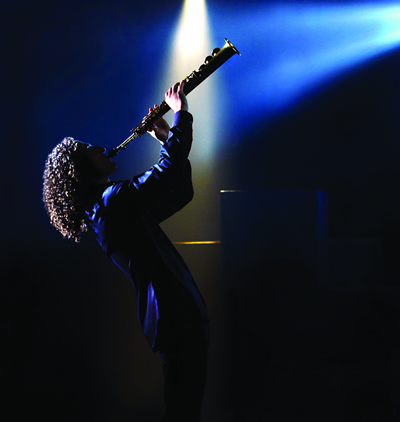The child in me nearly screamed delightedly when it read that a large perpetual motion machine awaited me at the Gregg Museum of Art and Design at North Carolina State University. It is one item in an extraordinary show dubbed “Farfetched: Mad Science, Fringe Architecture, and Visionary Engineering.” I looked carefully for a switch or anything else that would turn the majestic rotors. After all, Harry LeRoy Brunson had worked on it for 60 years. Then I read the wall label. Brunson depended on “devine (sic) intervention” to run what he labeled the “Biblical Perpetual Motion” machine.
Nearby was Richard Brown’s imaginative “Future Past,” filling the space between earth and heaven, as oddly-shaped glittering spaceships floated above tall structures below. Drawings of futuristic cities and buildings surrounded me as I walked among the work of some 30 creators placed in the show by its co-curators, Gregg Director Roger Manley and Tom Patterson. Perhaps unfortunately, Manley’s introductory wall note seeks to give the exhibition a serious twist by reminding us that “oddball mavericks and outsiders have made many of greatest contributions to modern civilization…. Remember that at one time or another belief in germs, quarks, black holes, meteorites, fossils, blood circulation or continental drift was considered laughably wrongheaded.”
I might take Manley’s comment with a straighter face if the very first artifact inside the Gregg’s door was not Sean Pace’s wonderfully useless “Death Slapper.” Unlike the Biblical Perpetual Motion machine, it does provide a switch that makes a group of unrelated objects whir to life, among them three rubber goslings revolving on a wheel and, one by one, slapping a mounted human skull. I flicked the switch more times than I care to divulge. I flicked another switch to start Duncan Laurie’s “Purr Generator,” standing next to the Slapper. The wall note informed me that it has seen several decades of improvements by a number of “gifted basement inventors.” Stretch out in it, turn it on, and you will be sandwiched by sounds from above and below, presumably intended to soothe you.
In the large main gallery I spotted a “Fantasy Gun” composed of tin cans, a light bulb and any number of other scraps found by Andre Robillard on the hospital grounds where he has lived since his violent childhood brought him there. Now quite gentle and more a worker than a patient, Robillard continues to make “weapons” but also has become a well-known maker and exhibitor of Art Brut. Clayton Bailey, who had a very different rearing, fills a case with a number of “Ray Guns” made of old power tools and appliances. With a master’s in art, Bailey taught ceramics and created an enormous number of robots and other oddities that he has on display elsewhere.
The walls were agleam with bright science-fiction spinoffs like Charles Dellschau’s carefully drawn and painted “airships,” none very airworthy, though Dellschau’s notebooks speak of an anti-gravity gas employed by a secret society of inventors. A group of large drawings of UFO’s by Ionel Talpazan went several steps beyond the usual approach, supplying diagrams of their internal structure and explanatory texts. Drawings of futuristic cities and buildings surround you as you walk among the near 30 creators chosen by Manley and Patterson.
As you might gather from Brunson’s “Biblical” machine, there is a good deal of religiosity among the outsiders, and the term “visionary” in the show’s title may at times be taken literally. Richard Brown insists that his work is a collaboration between himself and Jesus. Zebedee B. Armstrong, who worked in cotton fields and a box factory, had a vision about the end of the world, built and painted a motley array of devices to predict the exact date of the End and Day of Judgment, and bilked his neighbors with promises to repay their savings with interest the day after The Day (he died first). Several in the show gave themselves extraordinary titles: after a visionary experience of his own, Eddie Owens Martin dubbed himself St. EOM the Pasaquoyan. Royal Robertson renamed himself the Libra Patriarch Prophet Lord Archbishop Apostle Mystic Saint Royal Robertson.
This remarkable show may be seen through April 26. For details, see the sidebar.











